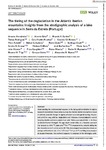Mostrar o rexistro simple do ítem
The Timing of the Deglaciation in the Atlantic Iberian Mountains: Insights From the Stratigraphic Analysis of a Lake Sequence in Serra Da Estrela (Portugal)
| dc.contributor.author | Hernández, Armand | |
| dc.contributor.author | Sáez, Alberto | |
| dc.contributor.author | Santos, Ricardo N. | |
| dc.contributor.author | Rodrigues, Teresa | |
| dc.contributor.author | Martín-Puertas, Celia | |
| dc.contributor.author | Gil-Romera, Graciela | |
| dc.contributor.author | Abbott, Mark | |
| dc.contributor.author | Carballeira, Rafael | |
| dc.contributor.author | Costa, Pedro J. M. | |
| dc.contributor.author | Giralt, Santiago | |
| dc.contributor.author | Gomes, Sandra D. | |
| dc.contributor.author | Griffore, Melissa | |
| dc.contributor.author | Ibáñez-Insa, Jordi | |
| dc.contributor.author | Leira, Manel | |
| dc.contributor.author | Moreno, João | |
| dc.contributor.author | Naughton, Filipa | |
| dc.contributor.author | Oliveira, Dulce | |
| dc.contributor.author | Raposeiro, Pedro M. | |
| dc.contributor.author | Trigo, Ricardo M. | |
| dc.contributor.author | Vieira, Gonçalo | |
| dc.contributor.author | Ramos, Alexandre M. | |
| dc.date.accessioned | 2023-03-28T15:48:33Z | |
| dc.date.available | 2023-03-28T15:48:33Z | |
| dc.date.issued | 2023-02-07 | |
| dc.identifier.citation | Hernández, A., Sáez, A., Santos, R.N., Rodrigues, T., Martin-Puertas, C., Gil-Romera, G. et al. (2023) The timing of the deglaciation in the Atlantic Iberian mountains: Insights from the stratigraphic analysis of a lake sequence in Serra da Estrela (Portugal). Earth Surface Processes and Landforms, 48( 2), 233– 242. Available from: https://doi.org/10.1002/esp.5536 | es_ES |
| dc.identifier.issn | 1096-9837 | |
| dc.identifier.uri | http://hdl.handle.net/2183/32796 | |
| dc.description | Financiado para publicación en acceso aberto: Universidade da Coruña/CISUG | |
| dc.description.abstract | [Abstract] Understanding the environmental response to the last glacial termination in regions located in transitional climate zones such as the Atlantic Iberian mountains is crucial to estimate potential changes in regions affected by current glacial melting. We present an 8.5 m-long, solid last deglaciation and Holocene chronostratigraphic record including detailed sediment analysis from Lake Peixão, a pro-glacial lake in the Serra da Estrela (Central Portugal). The age–depth model relies on a Bayesian approach that includes 16 AMS 14C dates and 210Pb–137CS measurements, robustly dating the lake formation at 14.7 ± 0.32 cal. ka BP. This chronological reconstruction shows an average sedimentation rate of ca. 0.07 cm yr−1 (15 yr cm−1), enabling proxy analyses at decadal timescales. The sediment sequence is composed of five lithological units: (U1) coarse and unsorted fluvioglacial lacustrine deposits; (U2) massive fluvioglacial lacustrine deposits (863–790 cm below surface [bsf]; 14.7 ± 0.32–13.8 ± 0.12 cal. ka BP); (U3) water current fluvioglacial lacustrine deposits (790–766 cm bsf; 13.8 ± 0.12–12.9 ± 0.29 cal. ka BP); (U4) laminated/banded lacustrine deposits characterized by terrigenous deposits from ice-covered lake periods and episodic events of ice and snow melting (766–752 cm bsf; 12.9 ± 0.29–11.7 ± 0.15 cal. ka BP); and (U5) massive muddy lacustrine deposits (752–0 cm bsf; 11.7 ± 0.15 cal. ka BP–present). The occurrence of U2 to U4 deposits defines the transition from glacial cold (U1) to net warm postglacial conditions (U5). These climate transitions are marked by changes in sediments and the presence of very low sedimentation rate periods, possibly related to the Intra-Allerød Cold Period and the coldest phase of the Younger Dryas. Our results support the previously proposed timing of the retreat of the Serra da Estrela glaciers ca. 13.8 ± 0.12 cal. ka BP. The robust chronology of Lake Peixão highlights the potential of Iberian pro-glacial lakes for dating deglaciation processes and will lead to unprecedented decadal-to-centennial timescale palaeoclimate reconstructions in this region since the last glacial–interglacial transition. | es_ES |
| dc.description.sponsorship | This work was supported by the Portuguese Foundation for Science and Technology – FCT, through the HOLMODRIVE project (PTDC/CTA-GEO/29029/2017). A. Hernandez is funded by the Spanish Ministry of Science and Innovation through the Ramón y Cajal Scheme [RYC2020-029253-I]. C. Martin-Puertas is funded by UKRI-FLF MR/W009641/1. G. Gil-Romera is funded by the DFG project FOR2358 ‘The Mountain Exile Hypothesis’. Pedro M. Raposeiro was funded by the Portuguese Science Foundation through contract DL57/2016/ICETA/EEC2018/25. Alexandre M. Ramos is funded by the Helmholtz ‘Changing Earth’ programme. Funding for open access charge: Universidade da Coruña/CISUG. The Estrela UNESCO Global Geopark is thanked for their support with field activities and permissions. The Parque Natural da Serra da Estrela (ICNF) provided research permits. | es_ES |
| dc.description.sponsorship | Deutsche Forschungsgemeinschaft; FOR2358 | |
| dc.description.sponsorship | Portugal. Fundação para a Ciência e a Tecnologia; DL57/2016/ICETA/EEC2018/25 | |
| dc.description.sponsorship | Portugal. Fundação para a Ciência e a Tecnologia; PTDC/CTA-GEO/29029/2017 | |
| dc.description.sponsorship | UK Research and Innovation; UKRI-FLF MR/W009641/1 | |
| dc.language.iso | eng | es_ES |
| dc.publisher | Wiley | es_ES |
| dc.relation | info:eu-repo/grantAgreement/AEI/Plan Estatal de Investigación Científica y Técnica y de Innovación 2017-2020/RYC2020-029253-I/ES/ | es_ES |
| dc.relation.uri | https://doi.org/10.1002/esp.5536 | es_ES |
| dc.rights | Atribución 4.0 Internacional | es_ES |
| dc.rights.uri | http://creativecommons.org/licenses/by/4.0/ | * |
| dc.subject | Climate change | es_ES |
| dc.subject | Geochronology | es_ES |
| dc.subject | Holocene | es_ES |
| dc.subject | Iberian Peninsula | es_ES |
| dc.subject | Lake sediments | es_ES |
| dc.subject | Late glacial | es_ES |
| dc.subject | Palaeoclimate | es_ES |
| dc.title | The Timing of the Deglaciation in the Atlantic Iberian Mountains: Insights From the Stratigraphic Analysis of a Lake Sequence in Serra Da Estrela (Portugal) | es_ES |
| dc.type | info:eu-repo/semantics/article | es_ES |
| dc.rights.access | info:eu-repo/semantics/openAccess | es_ES |
| UDC.journalTitle | Earth Surface Processes and Landforms | es_ES |
| UDC.volume | 48 | es_ES |
| UDC.issue | 2 | es_ES |
| UDC.startPage | 233 | es_ES |
| UDC.endPage | 242 | es_ES |
| dc.identifier.doi | 10.1002/esp.5536 |
Ficheiros no ítem
Este ítem aparece na(s) seguinte(s) colección(s)
-
GI-GRICA - Artigos [49]
-
GI- BIOCOST - Artigos [45]






